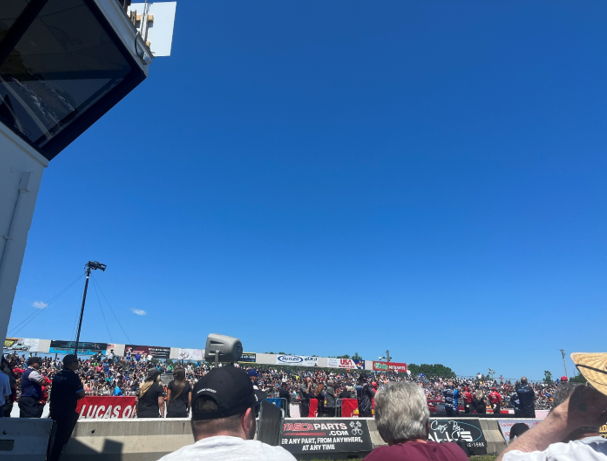
A Top Fuel Dragster sits in the pits as the pit-crew work on the car before it’s time to race. ZACH LAIRD photo
By ZACH LAIRD
EPPING, NH – By Saturday afternoon, a sea of people had gathered around the hot, sunbaked track to hear the godly crackle of thunder as high-powered engines boomed toward the finish line at over 300 mph.
The NHRA New England National Dragway 2024 Nationals rallied a national audience to see racers qualify for the high-staked finals. What resulted was not just another sellout crowd watching a spectacle of smoke and blurs zooming down the track—but instead an experience that might only accurately be described as like the Kentucky Derby on steroids.
For something as simple as a long, straight track that stretches a quarter mile (or 1,320 feet), the journey from general-admission parking is a long trek through a labyrinth of cars, trucks and trailers. Winding dirt roads lead to a maze of campers parked in a vast grid across huge fields of dirt, where countless families settled, days before to beat the crowds passing time with cornhole and cookouts.
Even before the rippling, explosive echo of engines dueling for a spot in the finals, the entire Dragway was packed with people waiting for the action to start. Aside from the audience jammed in the stadiums that stretched along the track, the lanes of concession stands and beer-tents stretched as far as the eye can see. Waves of people mingled, shopped, and watched pit-crews tinker with the cars before showtime.
“I’ve been coming to the track for about seven or eight years now”, said Mark Anderson from Haverhill, Mass. Anderson, 50, is a self-proclaimed frequent-flyer of the New England Dragway. “It’s always just a huge thrill—being here, around the track, it feels more like a kind of way of life than just a sport.”
“People come from all over,” Anderson continued, “and the drivers always give the race their all, no matter what. It’s a great time.”
The day kicked off with a slew of professional racers competing to qualify for the Elimination Rounds of the NHRA New England Nationals. As more and more people flocked toward the starting line in a frantic hurry to peak over the fence, the cars inch toward the pre-stage lights.
Then, after a few seconds of pure silence, a cosmic shatter reverberates from your teeth and travels through your central nervous-system, like a bolt of lightning. A flash of flames and smoke tear down the quarter-mile track, and before you know it, the tall speed-boards on either side of the track that stand 20-feet high light-up with times so quick, it feels like an instant.
The sport itself does the work of seeding out the newcomers from the frequent-flyers—as spectators peer over at the pit-crews toying with the cars before takeoff, the established come equipped with ear-plugs. The quick vibrations of the cars roaring across the track lingers like pins-and-needles in your fingertips, with enough kick to make your toes curl.
While drag-racing might have drifted into Massachusetts in 1953—according to the NHRA history page—the track itself didn’t spring to life until 1966. The track itself has a unique history—having been built with numerous racers who still own the track to this day. The New England Dragway is also the only ¼ mile drag strip track in New England.
The main competing categories can be put into three different classes. The first class, Top Fuel Dragsters, is comprised of the long, narrow body with massive supercharged engines in the rear. Fastest of the three classes, cars in Top Fuel are capable going from 0 to over 300mph within four seconds. The cars can average around 11,000hp (horsepower).
Funny Cars, on the other hand, operate with different body styles than Top Fuel yet race at similar speeds, which helped dub the name of the second class. While the appearance of a fiberglass body distinguished Funny Cars from other classes, both classes use supercharged engines with methanol and nitromethane. They also utilize similar automatic transmissions.
Pro Stock is a different matter. These cars look like production cars, but have been highly worked on and toyed with to withstand high-stakes performances like drag-racing. Unlike the two classes before it, Pro Stock uses naturally aspirated engines, which typically resemble original factory designs.
More than glorified rubber-burning contests, the sport represents more. The competition stands as the pinnacle of talent and teamwork, a tentpole of the racing elite within the Northeast. A near-total sellout, spires of bodies stood and sat in the grandstands with electric energies as the qualifying duels turned to final elimination rounds—that’s where you could feel the change in the air, that instinct that tells you all games are over.
The same feeling seemed to hit the crowd when Doug Kalitta sinched a close victory from Tony Schumacher in Top Fuel final eliminations at 332.9mph to 201.4mph. Or when John Force dueled his teammate, Austin Prock, for the title of Funny Car world champion. This marked the 16th time Force, 75, has been dubbed world champion for Funny Car.
The win for Force stood out that weekend like a glaring highlight, as Force booms away into the finals after also dueling J.R. Todd, Blake Alexander and Buddy Hull for another chance at the title. During the 11th annual NHRA New England Nationals, fans got to witness the culmination of skill, speed and courage.
As for Pro Stock, the Erica Enders, 40, anchored a lightspeed win against Troy Couglin Jr. with a winning time of 6.563 to Coughlin Jr.’s 6.584. One of the tightest duels of the day, Enders inched her way toward another victory, making another memorable run for drivers and fans alike.





